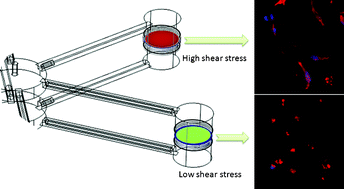A multi-shear perfusion bioreactor for investigating shear stress effects in endothelial cell constructs†
Abstract
Tissue engineering research is increasingly relying on the use of advanced cultivation technologies that provide rigorously-controlled cell microenvironments. Herein, we describe the features of a micro-fabricated Multi-Shear Perfusion Bioreactor (MSPB) designed to deliver up to six different levels of physiologically-relevant shear stresses (1–13 dyne cm−2) to six cell constructs simultaneously, during a single run. To attain a homogeneous fluid flow within each construct, flow-distributing nets photo-etched with a set of openings for fluid flow were placed up- and down-stream from each construct. Human umbilical vein endothelial cells (HUVECs) seeded in alginate scaffolds within the MSPB and subjected to three different levels of shear stress for 24 h, responded accordingly by expressing three different levels of the membranal marker Intercellular Adhesion Molecule 1 (ICAM-1) and the phosphorylated endothelial nitric oxide synthetase (eNOS). A longer period of cultivation, 17 d, under two different levels of shear stress resulted in different lengths of cell sprouts within the constructs. Collectively, the HUVEC behaviour within the different constructs confirms the feasibility of using the MSPB system for simultaneously imposing different shear stress levels, and for validating the flow regime in the bioreactor vessel as assessed by the computational fluid dynamic (CFD) model.


 Please wait while we load your content...
Please wait while we load your content...